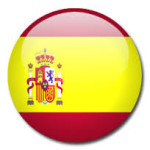1. When you look at a word, you know exactly how to pronounce it. There are no exceptions.
2. Each vowel in Spanish has only one sound. There are no exceptions.
Portuguese and French are like English. When you look at a word, you can get an idea of how it is pronounced. But there are lots of exceptions. With Spanish, what you see is what you get.
 Because of these two pieces of good news, many people say that Spanish is easy to learn. It is not. It is simply easier in Spanish to get to a 2 on a scale of 10 than it is in Portuguese or French. This is true because the phonetics (the sounds) are easier, as mentioned above. And since the phonetics represent the first building blocks, you can get through them faster and thus reach a 2 on a scale of 10 faster than you can in the other two. But to go from a 2/10 to an 8/10 (defined as total fluency, good but not perfect pronunciation, with an occasional error from time to time) in Spanish requires as much work as it does to do the same in Portuguese or French.
Because of these two pieces of good news, many people say that Spanish is easy to learn. It is not. It is simply easier in Spanish to get to a 2 on a scale of 10 than it is in Portuguese or French. This is true because the phonetics (the sounds) are easier, as mentioned above. And since the phonetics represent the first building blocks, you can get through them faster and thus reach a 2 on a scale of 10 faster than you can in the other two. But to go from a 2/10 to an 8/10 (defined as total fluency, good but not perfect pronunciation, with an occasional error from time to time) in Spanish requires as much work as it does to do the same in Portuguese or French.
 The proof of this is that we all have friends and colleagues who studied Spanish for multiple years in high school and college and never got within 15 miles of being able to speak and understand it at even a level of 5/10. They are able to repeat a few pat phrases in Spanish that they learned in school, but they have no clue of understanding even the simple phrases that come back to them from a native speaker.
The proof of this is that we all have friends and colleagues who studied Spanish for multiple years in high school and college and never got within 15 miles of being able to speak and understand it at even a level of 5/10. They are able to repeat a few pat phrases in Spanish that they learned in school, but they have no clue of understanding even the simple phrases that come back to them from a native speaker.
All languages have four dimensions: two active and two passive. The two active dimensions are speaking and writing where one has the responsibility of generating the message. The two passive dimensions are understanding and reading where one receives and interprets a message generated by the other person. To be judged “fluent,” one needs to get to an 8/10 in two of the dimensions and no less than a 7/10 in the other two.
 Since Spanish is spoken as a first language in Spain and in several countries in the Americas and the Caribbean, there is great diversity in accent, and to a lesser degree in vocabulary. But business Spanish has much less variation and is readily understood across the spectrum of the several Spanish-speaking countries. It can be compared to the Standard English that one hears on a TV network newscast in the U.S. or in the U.K. It is a middle of the road Spanish that avoids regional vocabulary and regional accents. Some linguists refer to it as “neutral” Spanish.
Since Spanish is spoken as a first language in Spain and in several countries in the Americas and the Caribbean, there is great diversity in accent, and to a lesser degree in vocabulary. But business Spanish has much less variation and is readily understood across the spectrum of the several Spanish-speaking countries. It can be compared to the Standard English that one hears on a TV network newscast in the U.S. or in the U.K. It is a middle of the road Spanish that avoids regional vocabulary and regional accents. Some linguists refer to it as “neutral” Spanish.
This is the Spanish that we teach at Transaction Linguistics.

 Enter Your Name and Email Address BELOW to Get a FREE Copy of "Learning a Foreign Language is a Physical Not An Intellectual Exercise"
Enter Your Name and Email Address BELOW to Get a FREE Copy of "Learning a Foreign Language is a Physical Not An Intellectual Exercise"